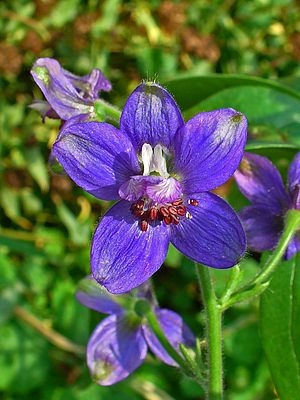ἀγριοσταφίς
καὶ ἤδη γε ἄπειμι παρὰ τὸν ἑταῖρον Κλεινίαν, ὅτι πυνθάνομαι χρόνου ἤδη ἀκάθαρτον εἶναι αὐτῷ τὴν γυναῖκα καὶ ταύτην νοσεῖν, ὅτι μὴ ῥεῖ. ὥστε οὐκέτι οὐδ' ἀναβαίνει αὐτήν, ἀλλ' ἄβατος καὶ ἀνήροτός ἐστιν → and now I depart for my companion, Cleinias since I have learned that for some time now his wife is unclean and she is ill because she does not flow, therefore he no longer sleeps with her but she is unavailable and untilled
Greek (Liddell-Scott)
ἀγριοστᾰφίς: -ίδος, ἡ ἀγρία σταφίς, Ὀρνεοσοφ., κτλ· οὕτω παρὰ Γραμμ., ἀγριοστᾰφύλη, -σταφύλινον, -σταφυλίς.
Spanish (DGE)
-ίδος, ἡ
bot. estafisagria, albarraz o hierba piojera, Delphinium staphisagria L., Archig.Fr.16.29B, Gal.14.500, 542, Eutecnius Th.Par.51.26, Aët.2.233, Alex.Trall.1.587.24, 2.101.28, Gloss.Bot.Gr.382.7, Eumelus en Hippiatr.75.9, como equivalente de ἀγροτέρη σταφίς Sch.Nic.Th.943a.
Wikipedia EN
Staphisagria macrosperma, formerly known as Delphinium staphisagria, is a species of Staphisagria of the family Ranunculaceae. It used to belong to the subgenus or section Staphisagria of the genus Delphinium, but molecular evidence suggests Staphisagria should be a genus which is a sister group to the Aconitum-Delphinium clade. It is described botanically as a stoutly-stemmed, hairy biennial with large palmate leaves up to 6 inches (15 cm) across. The flowers are mauve-blue to blue, short-spurred, and up to 1 inch (2.5 cm) across, occurring in racemes. The plant grows to a height of 4–5 feet. It grows throughout the Mediterranean. All parts of this plant are highly toxic and should not be ingested in any quantity.
The genus name Staphisagria and the common name stavesacre come from the Ancient Greek name mentioned by Dioscorides, σταφὶς ἀγρία (staphis agria, "wild raisin"). Dioscorides described the plant as having wild grape vine-like leaves, but Barton and Castle considered the name as an allusion to the large wrinkled brown seeds. This name derivation by Barton and Castle seems to have been arrived at independently by a modern horticulturalist, David Bassett, who also gives a detailed account of his experiences in growing this species.
Ancient greek also called the plant φθειροκτόνον (phthiroctonon, "louse killer") because of its use in traditional medicine. This meaning is retained in many of the plant's common names in different languages, such as lice-bane in English, matapiojos in Spanish, bit otu in Turkish.
Wikipedia DE
Das giftige Stephanskraut (Delphinium staphisagria), auch Mittelmeer-Rittersporn, Stephanskorn, Giftiger Rittersporn, Läusepfeffer, Lauswurz, Läusezahn, Läusesamen, Kräusesamen (englisch: Stavesacre, französisch: Dauphinelle) genannt, gehört zur Gattung der Rittersporne (Delphinium), in der Familie der Hahnenfußgewächsen (Ranunculaceae). Der botanische Name Staphisagria leitet sich von den griechischen Wörtern staphis, »getrocknete Weinbeere« und agrios, »wild« her und bezieht sich auf die in Form und Größe kleinen Rosinen vergleichbaren Samen (Mauspfeffer, Laussamen) und/oder die denen des Weinlaubs ähnlichen Blätter des Läusekrauts.
Wikipedia FR
Delphinium staphisagria, la dauphinelle staphisaigre, est une espèce de plantes de la famille des Ranunculaceae, originaire du bassin méditerranéen. Ce sont des plantes herbacées annuelles ou bisannuelles, qui contiennent des alcaloïdes diterpénoïdes et sont traditionnellement utilisées pour lutter contre les poux (pédiculicides).
Autres noms communs : staphisaigre, herbe aux poux, herbe aux goutteux, raisin sauvage, pied-d'alouette staphisaigre.
Translations
ar: عائق جبلي; ca: estafisàgria; de: Stephanskraut; fa: زباندرقفا; fr: staphisaigre; hsb: hniduš; hu: csípős sarkantyúfű; io: stafisagro; ru: живокость аптечная; sv: giftriddarsporre; tr: bit otu; zh: 灭虱草

